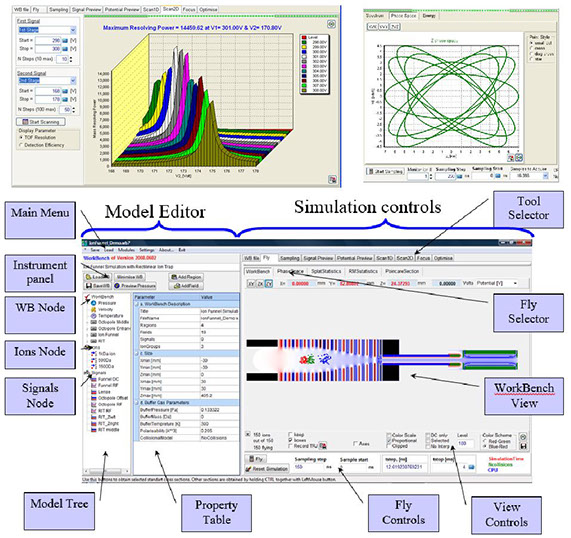SIMAX
Ion motion simulation software for the Dynamic Mass Spectrometry





SIMAX is a powerful tool, specially designed for dynamic mass spectrometry. Since dynamic mass spectrometry widely uses radio-frequency (RF) electrical fields for ion trapping and excitation, the primary target of SIMAX is to simulate ion motion in time-dependent electrical fields.
"SIMAX is an excellent software platform that allows the user to simulate complex geometries with great ease. Amazing functionality and high accuracy of simulations are available in a user friendly environment. This is a great tool to enhance our understanding of ion optical systems and design next generation mass spectrometry instrumentation." Dimitris Papanastasiou, CEO Fasmatech, Athens, Greece, http://fasmatech.com
Graphic User Interface

SIMAX
SIMAX is available in three versions

DEMO

RESEARCH

PROFESSIONAL
DEMO version allows to run examples, but does not allow to create or modify models. You can upgrade this version to RESEARCH or SIMAX PRO upon your payment.
SIMAX RESEARCH version is a powerful and fully functional software package, which allows you to simulate ion motion in electric and magnetic fields.
Upgrade this version to SIMAX PRO to get some extra capabilities.
SIMAX PRO offers additional tools and computational methods. With SIMAX PRO you can optimize your optical system using the Simplex method (the Amoeba algorithm) with an arbitrary target function. You can run simulations with ion-ion interactions using the direct Coulomb forces method, or using a simplified tree method. SIMAX Pro allows to compute induced charges (currents) on selected electrodes. The Fourier analysis can be applied to get components of the frequency spectrum.
NOTE:
SIMAX requires your electrode structures and potential arrays to be build and refined using SIMION 8.0/8.1 software package
DELIVER MAGIC TO MASS SPECTROMETRY

SIMAX versions
DEMO
RESEARCH
PROFESSIONAL
Capabilities
Description
+
+
+
Buffer gas properties
Distributed pressure, temperature and gas flow,
elevated buffer gas pressure
Ion-Gas Collisions
Random (Monte-Carlo) simulations of ion-neutral collision events, hard-sphere (billiard-ball), Linear Drag model, equation defined models,
Langevine (polarization model) velocity-dependent cross-section models, combined collisional models, data files
-
+
+
+
+
+
Standard RF waveform library
Sine wave, square wave, single pulse, periodic pulses, constant voltage, digital SQ wave, digital pulsed AC, digital sine AC, arbitrary digital waveforms
-
+
+
Space charge repulsion effects
Coulomb interactions between individual particles, approximate tree method
DESIGNED BY EXPERTS IN MASS SPECTROMETRY
SIMAX EXAMPLES
This Demo shows a model of a multireflecting Time-of-Flight instrument (IsoTOF).
The idea of the IsoTOF is to create a combination of two electrostatic fields to ensure space-energy focusing in the flight (X) direction. The second field focuses ions in the drift (Z) direction.
As a result, the ion beam undergoes a multi-reflection motion in the X direction before it is reflected back and focused to the detector in the drift direction.
This model demonstrates an operation of a single quadrupole mass analyzer with a collisional cooling interface. The fringing fields are compensated by the Brubaker pre-filters.
In this example SIMAX is used to compute stability diagram for a quadrupole mass filter with a pure hyperbolic field.
Here we demonstrate a powerful Scan2D tool to repeat simulations to define the transmission efficiency while scanning the RF amplitude and DC voltage within some region near the tip of stability diagram.

DOWNLOADS
DOWNLOAD
Ideal reTOF Demo (ZIP, 195.9 MB)
DOWNLOAD
FT-ICR Demo (ZIP, 4.0 MB)

Deliver Magic to Mass spectrometry
< Back to SOFTWARE
Back to Top
Email us:
mail@
mscube.co.nz
Visit us:
25 Jervois Road,
Ponsonby, Auckland
New Zealand
Find us:
Copyright © 2017 MSCUBE Ltd. All Rights Reserved



